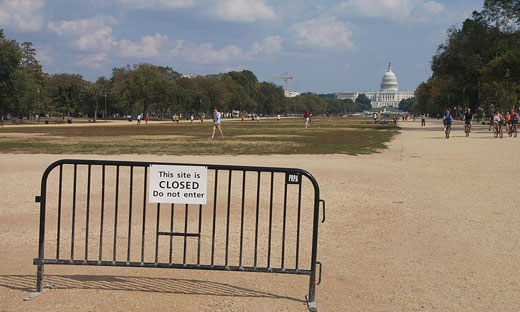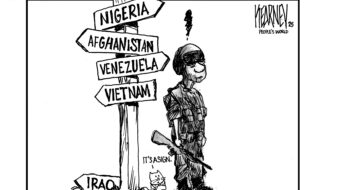
The settlement reached more than a week ago to reopen the federal government constituted a major victory for democratic governance. It firmly rebuffed a reckless attempt by a small group of right-wing extremists to leverage the routine lifting of the debt ceiling and funding of government operations (what the right wing calls “forcing events”) into something much more serious and consequential.
Defunding Obamacare and winning other White House concessions by undemocratic means was to be but the first trophy in a far more ambitious and longer term power play by a reactionary clique and their big-pocketed financial backers to reverse the 2012 election results (which left them, much to their surprise, in a subordinate position in Washington), disempower President Obama for the remainder of his term, bypass democratic institutions and rules, and, above all, impose its deeply reactionary political agenda on the country – not to mention position itself to gain control of Congress in 2014 and the presidency in 2016.
In an earlier article, I called this adventurist assault on our democracy a new phase of a very American coup. I would add, in hindsight, that it was not simply a new but a more dangerous phase in which this clique of right-wing extremists, not satisfied with obstructing the democratic will and majority rule, made a reckless bid to illegitimately install itself as the dominant political force at the federal level.
When that prospect is combined with the right-wing domination of roughly 25 state governments, which have turned into laboratories for far-right political, economic, and social policies, it should be frightening for anyone concerned about our country’s future.
That this extremist tea party crowd not only came up empty, but also with egg or worse on their faces, is explained by a combination of factors.
First, the president, to his credit, didn’t blink; he refused to give in to mafia-like extortion. He evidently understood, in no small measure from earlier experience with the sequester, that if he gave ground again it would be tantamount to surrendering his presidency and much more.
Second, the American people in their majority pierced through the “both sides responsible” sham. By the second week of the shutdown nearly three-quarters of the public fixed responsibility on the Republicans. This no doubt had a sobering impact on established and moderate voices in the GOP.
Third, the tea party wrongly assumed that people were ready to go to war over Obamacare. While many people may not like it, or the caricatured and distorted version of it that they are served up by right-wing media and politicians, few were ready to shut down the government in order to defund or repeal it.
Fourth, organized actions throughout the country stiffened the resistance of Democrats and were surely noted by Republicans representing swing districts.
Finally, pressure from Wall Street and other sections of big capital was a factor in forcing a settlement.
And that shows that this wasn’t a class war “pure and simple,” in which the class of capitalists lines up on one side, with the working class on the other.
Certainly, on one side was a coalition of right-wing forces, including a sliver of well heeled capitalists – the most racist, anti-labor, anti-democratic, and reactionary. However, on the other side was not only a majority of the American people, but also major sections of the capitalist class who, while sharing many of the near and longer term aims of right-wing extremists in the Republican Party, were not ready to risk pulling the plug on the economy in order to achieve them.
So much so that as the clock ticked down on lifting the debt ceiling, these capitalists brought their considerable weight to bear on Republican leaders in Congress to agree to a settlement that left Obamacare untouched and essentially mirrored what was on the table just prior to the shutdown.
While this meant throwing the tea party crowd under the bus and temporarily being in the company of people and organizations that are normally their adversaries, it was a price that big capital was ready to pay in order to guarantee the smooth reproduction of U.S. and world capitalism as well as maintain its role of global imperialist hegemon. Capitalists ruthlessly exploit crises and disasters to be sure, but most prefer a predictable economic and political environment in which to accumulate capital and profits; shocks to the system are not their favored cup of tea.
Thus, this was a particular kind of war that brought together a peculiar and motley grouping of people and social forces and turned, in the deepest sense, on the issue of democracy and democratic governance. It didn’t come close to lining up “class against class,” but its outcome will nonetheless impress itself on class as well as other democratic struggles going forward.
A dogmatic reading of Marxism would not allow us to make such an analysis. Instead this understanding follows from a Marxism that admits new experience, employs dialectics, and possesses an eye for the contradictory, concrete, and peculiar ways in which classes and people interact on the ground, far from the neat boundaries of abstract theory and rigidly constructed social categories.
It is said that the settlement does nothing more than “kick the can down the road.” This is true. The funding authorization for government agencies expires January 15, the debt limit will be revisited a few weeks later on February 7, and spending levels remain at sequester (depressed) levels.
But the lay of the land has changed in contradictory and significant ways in the course of this struggle.
The tea party and Republican Party overall have been weakened. Smarting from the disappointing results of last year’s elections, party leaders had hoped to rebrand themselves, to adjust their image and message to new demographic and cultural realities.
But even before the shutdown, their rebranding efforts were limping along. Now, with the shutdown debacle, they have dug themselves into a much deeper hole.
Moreover, Republicans emerge out of the shutdown not only with a stained brand, but also in disarray, with pronounced tensions and splits. Some of this will be played out in GOP primaries in the coming year.
That will make a Republican comeback more difficult.
The president and Democrats overall, on the other hand, come out of this struggle energized, if not fully united.
Beyond Washington, in the wake of the shutdown growing numbers of American people possess a far keener sense of the danger of right-wing extremism if not checked. The school of experience can be an insightful teacher, as it was in this case, about the particular role of various political forces in society. This has the potential of giving added reach, strength and unity to the movements and coalitions battling the far right at the national, state, and local level.
And the organized working class and democratic movements exit the shutdown struggle with more bounce in their step too. Their leaders almost to a one have expressed their determination to reframe the coming battle over the federal budget as a battle for people’s needs rather than austerity; to press ahead on jobs, infrastructure renewal, and safety net programs; to regain the initiative on comprehensive immigration reform, including an immediate halt to deportations; to vigorously oppose construction of the Keystone pipeline; and to resist any cuts or “reforms” in earned income benefit programs.
They are also turning their attention to the 2014 mid-term elections where the prospects of defeating the right have appreciably improved in the aftermath of the shutdown.
Sounds promising, but no one should conclude from this that the sailing ahead is going to be easy.
Finance capital and its class partners will regroup. Their differences with Republican leaders and firebrands were more tactical than strategic. They will find common ground in pressing a right-wing agenda in the immediate budget battles over spending, taxes, and “entitlement” reform.
Nor can the broader movement have complete confidence in the centrist and blue dog groupings in the Democratic Party. These elements don’t embrace the economic program of their far-right adversaries, but too many operate within the frame of austerity, deficit reduction, and cutting, if not eliminating, earned income benefits programs.
Finally, right-wing extremists and their corporate sponsors lost the shutdown battle, but they remain a formidable force and their strategic goal is unchanged: not simply to shrink, but to take over the federal government and then wield federal and state power to recast politics, economics, culture, public opinion, and society in their interests and image.
Thus the struggle against right-wing extremism continues to be the overriding strategic task of the working class and democratic movements.
That doesn’t mean tamping down confrontations with corporate capital or reining in more fundamental answers to current problems or silencing anti-corporate and radical ideological voices or corralling the search for new forms of political independence or building the left in size and influence. On the contrary, just the opposite is needed.
But it does mean grasping that the pathway to restructuring our institutions and policies in a consistently anti-corporate direction – not to mention advancing to socialism – will only fully open up to the degree that the right wing is decisively defeated.
But for that to happen, the organized labor and people’s movements will have to act with even greater vigor ideologically and practically. The task is no less than empowering, energizing, uniting, and raising the understanding of vast numbers of the American people in the context of sustained struggle for their immediate needs, and in diverse arenas of struggle – not least of which is the fall elections next year.
Of critical importance is the fight against racism in its material, institutional, and ideological forms. Racism was the main vehicle to bust up the New Deal coalition and fuel the ascendancy of the right wing to its prominent position in American political life. So too the struggle against racism in its old and new forms will be at the core of building a movement that possesses the ideological, political, and organizational capacity to dislodge the right wing from its positions of power and usher in an era of deep-going progressive, even radical, change.
And finally, if earlier periods of transformative change offer lessons, it is imperative that the left, broadly defined, play a active role in this process. But for that to happen, it (and I include the communists) will have to demonstrate the same willingness as our sisters and brothers in labor are showing to changing and adapting itself to new conditions, challenges, and sensibilities of this era.
Photo: The “people’s park” – the National Mall – was forced to close by the shutdown. The U.S. Capitol is in the background. Photo taken Oct. 6, 2013. Wikimedia Commons










